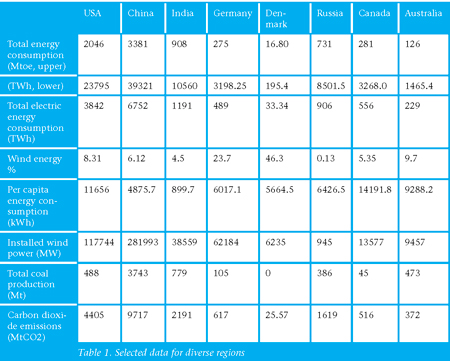 It came to my mind to do some calculations of how many wind turbines we need to power the whole world with renewable energy. Of course, in the future when we run out of fossil fuels, or we are forced not to use fossil fuels any more to survive on Planet Earth, wind will not be the only alternative source of energy. Considering that hydro, wind, solar, wave, geothermal and other renewables may provide say 70–80% of the world’s energy needs in the future, it is reasonable to predict that wind energy will account for over 20%.
It came to my mind to do some calculations of how many wind turbines we need to power the whole world with renewable energy. Of course, in the future when we run out of fossil fuels, or we are forced not to use fossil fuels any more to survive on Planet Earth, wind will not be the only alternative source of energy. Considering that hydro, wind, solar, wave, geothermal and other renewables may provide say 70–80% of the world’s energy needs in the future, it is reasonable to predict that wind energy will account for over 20%.By Ahmad Hemami, McGill University, Montreal, Canada
This question can be interesting to view the state of the supply of, and demand for, wind turbines in say 50 years from now. It is, however, not an easy question to answer. In other words, any number that we come up with can only be a crude answer.
I started gathering numbers for various issues that are involved: How large is the world energy need? What is the current percentage of wind energy? How many turbines are providing this energy? How much is the per capita energy consumption? All these questions need to be answered for all countries. By itself, this becomes a huge project, involving many parameters, even if the relevant data is available.
To make it more manageable, I decided to gather data only for a selected number of countries (Table 1). The reason for selecting these places is that each one has a particular characteristic that can be common in many other regions. For instance, Germany can be considered representative of other European countries, but on the other hand, Denmark is the country with the highest share of wind power, where no other country is even close.
The numbers in Table 1 are from various national or international sources that are available online. Sometimes the same data do not exactly match from different sources, even if they refer to the same calendar year. It is obvious that gathering information is a large part of the effort needed to provide this data, and always one expects some degree of uncertainty in the information.
For the total energy consumption, the available data is in million tonnes of oil equivalent (Mtoe). To be compatible with the other data, it has also been converted into TWh for better clarity (1 Mtoe = 11.63 TWh).
For the per capita energy consumption, my intention was to enter the average energy consumption per household for each country (separating the residential consumption from the rest), but the data is not readily available, if at all. Even for the USA and Canada, for which I have been able to find some data, there are two important issues: 1) houses are not the same size and 2) they are not in the same region (from heating or cooling viewpoints). Also, the average values can vary widely. For example, according to US Energy Information Administration 2019 data, for an average annual per person total energy consumption of 305 million Btu (321.79 GJ, 89.4MWh), the actual data ranges between 180 and 932 million Btu, i.e. from 59 to 306% of the average. According to the same source, the world average per capita consumption of primary energy in 2018 was about 79 million Btu, i.e. about 26% of that of the USA.
To answer the question of how many turbines, we should first decide on the turbine size. According to the American Clean Power Association (formerly the American Wind Energy Association) there are 65,000 wind turbines in the USA producing 125GW of power in total. But many of these turbines are small and/or obsolete and need to be repowered. Although this can be the typical scenario in most other places, it is more reasonable to assume new turbine installations to be in the range of 5 to 10MW, since many of them will be onshore. It is true that newer offshore turbines are larger and 20MW is on the horizon, but for onshore locations or those behind in technology, 5MW turbines can be very common, even years from now. Thus, an average turbine size of 7.5MW is not unrealistic.
Based on current US production, a wind power share reaching 20%, and current energy consumption, the number of 7.5MW turbines needed to power the USA is 40,000. Extrapolating this for the whole world, based on the population and taking into account the per capita consumption mentioned previously (26%), the number of turbines required reaches 247,000. This number is based on 2020 data for almost every parameter involved. It is to be considered that both the world’s population and the per capita energy consumption are on the rise. Also, this has been based on the share of wind energy reaching 20%, which is an average value. Nonetheless, it can be used as an index.